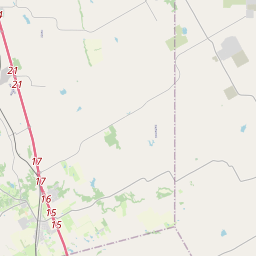First Presbyterian Church Building







The Rev. J. A. Smiley organized the First Presbyterian Church in 1871 with 16 charter members. The first church building was erected in 1876 and replaced by this structure in 1916-17. After this congregation merged with another church in 1979, the building was sold to the Ellis County Art Association for use as a fine arts museum. It is a fine example of a classical church with beaux arts details in its modified Doric columns and art glass windows.
Recorded Texas Historic Landmark - 1997
As one of the most visible programs of the Texas Historical Commission (THC), historical markers commemorate diverse topics in Texas history, including: the history and architecture of houses, commercial and public buildings, religious congregations, and military sites; events that changed the course of local and state history; and individuals who have made lasting contributions to the state, community organizations, and businesses.
Texas is also home to the world's largest honky-tonk, Billy Bob's Texas in Fort Worth. The venue covers three acres and can hold up to 6,000 people.
The area that is now Ellis County was initially inhabited by Native American tribes, including the Caddo and Comanche. However, in the mid-1830s, European settlers began to arrive and establish homesteads in the region. These settlers were drawn to the fertile land and opportunities for farming and ranching.
During the Civil War, Ellis County was deeply divided, with residents supporting both the Union and the Confederacy. The county was the site of several skirmishes and raids, and endured a significant amount of destruction as a result. After the war, Ellis County began to rebuild and experienced a period of growth and development.
In the late 19th and early 20th centuries, Ellis County saw the rise of industries such as cotton farming, cattle ranching, and oil production. The arrival of the railroad in the late 1800s further fueled the county's economic growth. Today, Ellis County remains an agricultural powerhouse, with a strong presence in the cotton and cattle industries, and is also home to a diverse range of businesses and thriving communities.
Ellis County Timeline
This timeline provides a concise overview of the key events in the history of Ellis County, Texas.
- 1849 - Ellis County is established from Navarro County.
- 1850 - Waxahachie is selected as the county seat.
- 1853 - The county courthouse is built.
- 1881 - The Texas Central Railroad reaches Waxahachie, boosting the local economy.
- 1883 - Southwestern Asylum for the Insane (now known as Terrell State Hospital) opens in Terrell, impacting the county's development.
- 1889 - A fire destroys the Ellis County courthouse.
- 1895 - A new courthouse is completed, designed by architect J. Riely Gordon.
- 1921 - An oil boom begins in Ellis County, leading to increased prosperity.
- 1934 - The Federal Correctional Institution is established in Seagoville.
- 1942 - The Naval Air Station is established in Waxahachie during World War II.
- 1969 - Navarro College opens a campus in Waxahachie.
- 1987 - Bluebonnet Festival debuts in Ennis, becoming an annual celebration.
- 2007 - Baylor Scott & White Medical Center opens in Waxahachie, providing advanced healthcare services to the county.